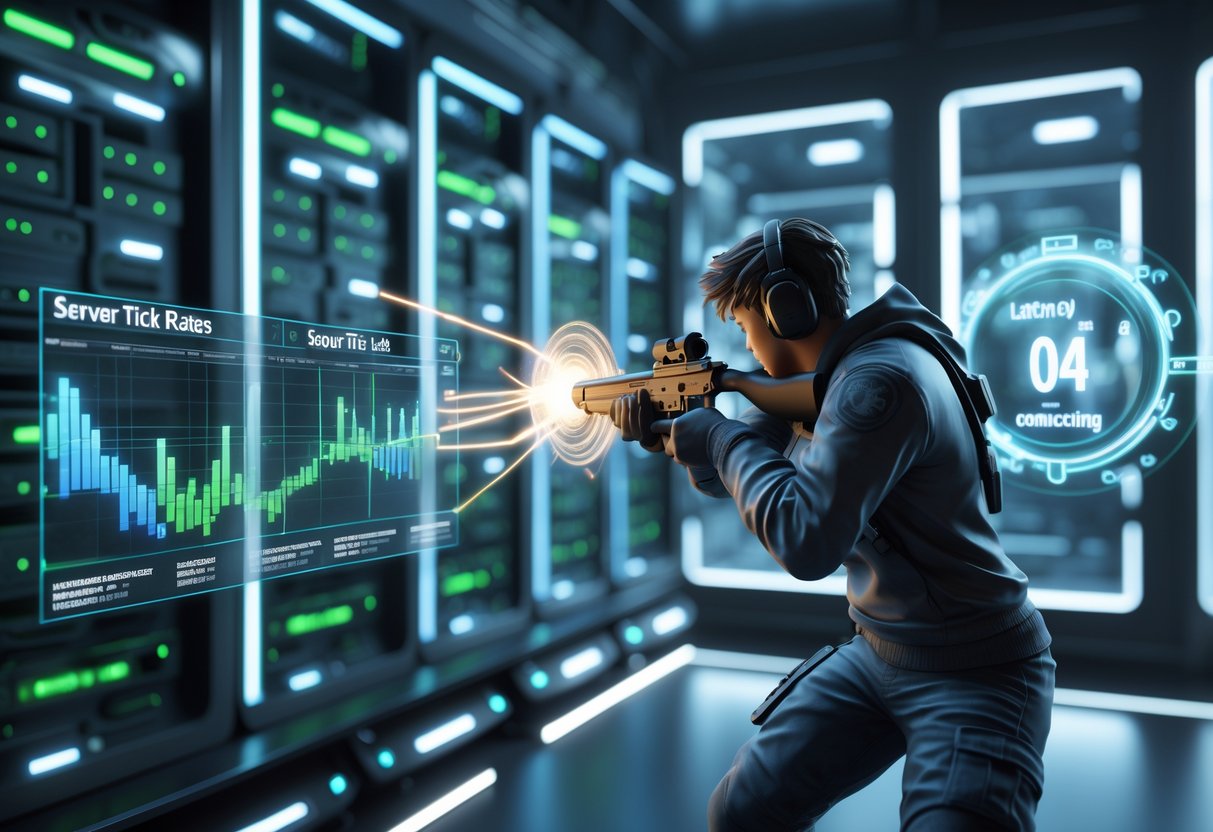Server Tick Rates: Essential Impacts on Multiplayer Gaming
Updated On: November 13, 2025 by Aaron Connolly
Defining Server Tick Rate

The server tick rate basically shows how often game servers update and process info from players. The update rate, on the other hand, is about how frequently that processed data gets sent back to your game client.
What Is a Server Tick Rate?
A server tick rate tells you how many times per second the game server updates the world. Measured in hertz (Hz), higher numbers mean the server updates more often.
It’s kind of like a clock ticking away. Each tick is a moment where the server takes all player actions, runs the game physics, and figures out what happens next.
Popular games run at different tick rates:
- Valorant: 128 Hz
- Counter-Strike 2: Sub-tick system
- Overwatch 2: 64 Hz
- Apex Legends: 20 Hz
- Fortnite: 30 Hz
If the tick rate is higher, the gameplay feels smoother. When servers update 128 times per second instead of just 20, your shots land more accurately and movement feels way more responsive.
How Ticks Operate in Game Servers
Game servers run a constant loop, processing player inputs every tick. The server grabs info from everyone connected, works out what should happen, then gets updates ready to send back.
During each tick, the server handles things like:
- Player movement and position
- Weapon shots and hit checks
- Item pickups and interactions
- Game physics
Here’s the basic tick process:
- Server gets player inputs
- Processes all actions together
- Updates the game state
- Prepares data for the next update
When tick rates drop, you get bigger gaps between updates. If you shoot between ticks, the server might not notice until the next cycle. That’s why sometimes you’re sure you hit someone, but nothing happens—super frustrating.
Server Tick Rate vs. Update Rate
Tick rate and update rate aren’t the same thing. Tick rate is about how often the server does its internal calculations. Update rate is how often your client receives those updates.
Main differences:
- Tick rate: How often the server processes (internal)
- Update rate: How often the client gets info (external)
Some games set different rates for each. For example, a server might process at 64 Hz but only send updates at 30 Hz to save bandwidth.
Why care? Your client update rate can’t go past the server’s tick rate. If the server runs at 30 Hz, you’ll never get more than 30 updates per second, no matter how fast your internet is.
Games like FIFA 23 use variable server rates, adjusting values based on server load and player count.
Core Mechanics of Server Tick Rates

Tick rates decide how often game servers process and update info for all players. This frequency shapes how smooth multiplayer games feel, affecting everything from hit registration to movement accuracy.
Frequency and Game State Updates
Tick rate shows how many times per second a server updates its game state. Most games run between 20Hz and 128Hz, so the server processes info 20 to 128 times each second.
Each tick, the server gets player inputs, processes changes, and sends info back to clients.
A 64Hz tick rate means updates every 15.6 milliseconds. At 128Hz, it’s just 7.8 milliseconds between updates.
Higher frequencies mean smoother gameplay. Players see positions more accurately, and hit registration gets a big boost.
But there’s a tradeoff: higher tick rates need more server performance. Doubling tick rate pretty much doubles the processing power needed.
| Tick Rate | Update Interval | Common Games |
|---|---|---|
| 20Hz | 50ms | Fortnite |
| 30Hz | 33ms | League of Legends |
| 64Hz | 15.6ms | CS2 matchmaking |
| 128Hz | 7.8ms | Valorant, CS2 premium |
The Role of Ticks in Multiplayer Games
Ticks keep all players in sync during multiplayer games. Without regular updates, everyone would see a different version of the match.
Every tick, the game server processes stuff like movement, weapon fire, abilities, and environmental changes. Then it sends these updates to everyone.
Low tick rates can cause “super bullets” where several shots stack up and hit all at once. Players might suddenly take a ton of damage instead of from separate hits.
Fast-paced shooters need higher tick rates than strategy games. A 20Hz rate is fine for turn-based games but messes up competitive FPS titles.
Quick tip: Check your game’s tick rate in network settings or console commands to see what you’re dealing with.
Simulation Rate in Online Environments
The simulation rate is how fast servers calculate physics, collisions, and player interactions. It’s a big deal for competitive integrity.
Servers have to balance accuracy against performance. Running complex calculations 128 times a second takes a lot of computing power and bandwidth.
Network conditions can mess with tick rates. If your internet can’t keep up, you won’t really benefit from 128Hz servers.
Many games use adaptive systems that tweak update rates based on server performance and player connections. This way, servers don’t get overloaded during busy times.
Heads up: Higher tick rates use more data, which can be a problem for mobile players or anyone with limited broadband.
Different parts of the game might update at different rates. For example, player positions might update at 64Hz, but environmental effects only update at 30Hz to save resources.
Impact on Online Gaming Experience
Server tick rate totally changes how smooth and responsive your online games feel. Higher tick rates shrink the delay between your actions and what you see, and they also help the game register your shots and movements more accurately.
Tick Rate and Responsiveness
Tick rate decides how fast the server processes your inputs and sends updates back. When you press a key or click, that action has to go to the server, get processed, and then return to your screen.
Games with 64-tick servers update 64 times per second, so there’s about 15.6 milliseconds between each update. With 128-tick servers, that delay drops to around 7.8 milliseconds.
You can really feel the difference in competitive games. If you’re playing Counter-Strike and peek around a corner, a higher tick rate means your movement shows up faster for everyone else. It also means their reactions hit you back faster, too.
Most casual players notice better responsiveness when switching from 64-tick to 128-tick servers. Your character just feels more connected to what you’re doing, especially during quick moves or tricky maneuvers.
Effects on Lag and Latency
Tick rate works together with your ping to shape your overall latency. Ping is the round-trip time for data between your computer and the server. Tick rate is about how often the server processes that data when it arrives.
Lower tick rates can cause lag—stuff like stuttering or rubber-banding. Sometimes your character jumps back a step or your commands take a weirdly long time to show up.
Here’s a quick look at how tick rate changes perceived lag:
| Tick Rate | Update Interval | Combined with 50ms Ping | Total Delay |
|---|---|---|---|
| 20-tick | 50ms | 50ms + 50ms | 100ms |
| 64-tick | 15.6ms | 50ms + 15.6ms | 65.6ms |
| 128-tick | 7.8ms | 50ms + 7.8ms | 57.8ms |
Don’t expect tick rate to fix a bad connection. If your ping is high because your internet sucks, raising tick rate won’t help much. A stable connection matters more for most people.
Server Tick Rate and Hit Registration
Hit registration is all about how well the game detects your shots landing on targets. Low tick rates can cause shots to look like they hit but not actually count, or you might die after ducking behind cover.
With 64-tick servers, the game checks for hits 64 times a second. If you shoot between those checks, your shot might not get counted. This stands out with fast-moving targets or when you’re spraying bullets.
128-tick servers are way better for hit detection. Doubling the update rate means fewer shots slip through the cracks. That’s why pro tournaments almost always use 128-tick servers.
Some common problems from low tick rates: • Shots look like hits but do nothing • Getting killed after you’re already behind cover • Weird, inconsistent damage from automatic guns • Delayed feedback when you land a shot
Heads up: Sometimes hit registration issues come from network problems, not just tick rate. Always check your connection stability before blaming the server.
Tick Rate in First-Person Shooter Games
First-person shooters really depend on tick rates for precise hit detection and snappy gameplay. Different games use different tick rates—Valorant runs on 128-tick servers, but CSGO matchmaking sticks to 64-tick.
Significance in FPS Titles
Tick rate directly changes how well your shots register in FPS games. You fire at someone, and the server has to process it and decide if it hit.
A higher tick rate means more frequent updates between your game and the server. This cuts down on those annoying moments when you shoot but nothing happens.
64-tick servers update 64 times a second. 128-tick servers double that. You’ll notice the difference in fast firefights.
If you have a 144Hz monitor, you’re seeing 144 frames per second. But if the server only sends 64 updates, things can feel off.
That’s why sometimes you get shot even though you’re already behind cover on your screen. The server hasn’t caught up to your movement yet.
Tick Rate Variations: CSGO and Valorant
FPS games really mix things up with tick rates:
Counter-Strike: Global Offensive:
- Official matchmaking: 64-tick
- FACEIT platform: 128-tick
- ESEA platform: 128-tick
Valorant:
- All official matches: 128-tick
Call of Duty: Modern Warfare:
- Multiplayer lobbies: 22-tick
- Custom games: 12-tick
Most of this comes down to cost. Running 128-tick servers eats up a lot more resources than 64-tick.
Valve keeps CSGO matchmaking at 64-tick to save money on servers. Third-party sites like FACEIT offer 128-tick as a premium perk.
Valorant launched with 128-tick everywhere to compete with other big FPS titles.
Influence on Competitive Play
Competitive FPS games really need tick rates of 60 or higher for fair play. Most pro tournaments go with 120 or 128-tick servers to reduce input lag.
Higher tick rates matter most for precision shots and quick moves. Pro players can spot the difference between 64-tick and 128-tick pretty much right away.
Quick tip: Try the same game on both 64-tick and 128-tick servers. You’ll feel the change.
Tick rate tweaks things like spray patterns, movement accuracy, and grenade throws. These little differences can decide matches at the top level.
Many semi-pro players say 128-tick servers just feel better and more accurate. That’s why competitive leagues pay extra for higher tick rates, even though it costs more.
Just remember: Don’t expect miracles from higher tick rates if your internet or hardware is holding you back.
Understanding High vs. Low Tick Rate
When you choose between high and low tick rates, it’s really a trade-off: accuracy or resource usage. Higher tick rates give you smoother gameplay and better hit detection.
Lower tick rates save bandwidth and server costs, but they can mess up your experience with frustrating gameplay hiccups.
Advantages of a High Tick Rate
High tick rate servers process game info more often. Your actions show up on screen faster and with better accuracy.
A 128Hz server updates 128 times every second. That’s double what a 64Hz server can do.
You’ll notice the difference right away.
Improved Hit Registration
Your shots connect when you expect them to. We’ve all felt the pain of landing a hit but seeing no damage.
High tick rate servers cut down on those moments.
Reduced Peeker’s Advantage
When someone peeks around a corner, both players see the action almost simultaneously. Lower tick rates can make it feel like attackers get a free shot.
Smoother Movement
Movement just feels more responsive. Quick turns, jumps, and precise moves happen as you intend.
Pro players almost always want high tick rate servers. They can react faster and trust the game info they see.
Drawbacks of a Low Tick Rate
Low tick rate servers bring a bunch of issues, hurting both casual and competitive play.
Delayed Action Registration
Your inputs take longer to show up. There’s a lag between pressing a button and seeing anything happen.
Inconsistent Hit Detection
Shots that look like they connect sometimes don’t. The server just isn’t updating fast enough to catch everything.
Increased Latency Issues
Network hiccups stand out more on low tick rate servers. Tiny connection problems can ruin a match.
Competitive Disadvantage
Players who react quickly get punished. The server can’t keep up with snappy movements or pinpoint aiming.
A lot of players feel like their skill barely matters on low tick rate servers. Good players sometimes perform worse since their precise actions aren’t recorded right.
Balancing Tick Rate and Performance
Server Performance shoots up with higher tick rates. A 128Hz server needs about twice the power as a 64Hz one.
Bandwidth Usage also climbs with tick rate. Higher rates mean more data flying between server and players every second.
| Tick Rate | Updates/Second | Bandwidth Impact | Performance Cost |
|---|---|---|---|
| 32Hz | 32 | Low | Minimal |
| 64Hz | 64 | Medium | Moderate |
| 128Hz | 128 | High | Significant |
Game developers have to look at their player base size. Supporting millions on 128Hz servers costs a lot more than running 64Hz.
Hardware Requirements
Servers need strong CPUs and fast network links. If the hardware isn’t up to the task, high tick rates can crash or lag at peak times.
Cost Considerations
High tick rates mean higher costs. Some studios offer premium high tick servers for a fee and keep lower rates for casual matches.
The “right” tick rate depends on the game. Fast shooters really need high tick rates, but strategy games get by just fine with less.
Popular Games and Their Default Tick Rates

Different games use wildly different tick rates. Apex Legends runs at just 20Hz, but Valorant goes for 128Hz.
FPS games usually need higher rates for competitive play. MOBAs often stick to lower rates and still feel fine.
Tick Rate Comparisons in Top Multiplayer Games
Tick rates can vary a ton between games. Here’s what some of the big titles use:
| Game | Tick Rate | Type |
|---|---|---|
| Valorant | 128Hz | Tactical FPS |
| CS | 64Hz/128Hz | Tactical FPS |
| Counter-Strike 2 | Sub-tick | Tactical FPS |
| Overwatch 2 | 64Hz | Hero Shooter |
| Call of Duty: Modern Warfare II | 60Hz | Fast FPS |
| Halo Infinite | 60Hz | Arena FPS |
| Rocket League | 60Hz | Sports |
| Dota 2 | 30Hz | MOBA |
| League of Legends | 30Hz | MOBA |
| Fortnite | 30Hz | Battle Royale |
| Apex Legends | 20Hz | Battle Royale |
| Warzone 2 | 20Hz | Battle Royale |
Battle royale games usually go with lower tick rates. With 100+ players, high rates would be too expensive.
MOBAs like League of Legends get by with 30Hz. You don’t need pinpoint aim, so the lower rate doesn’t hurt.
Why Do Some Titles Use 64 Tick or 128 Tick?
64 tick servers became the go-to for competitive FPS games. It’s a balance between performance and cost.
CS runs at 64Hz for normal matchmaking, but offers 128Hz for premium services.
That jump makes a real difference in how shots feel. Many players say 128 tick servers just feel better.
128 tick servers (like Valorant’s) offer the smoothest experience. The server updates twice as often, so your actions feel more instant.
But the price goes up. Running at 128 tick takes about double the server power and bandwidth. Not all studios want to pay for that, especially for casual playlists.
Some games use variable tick rates. FIFA 23 and Escape From Tarkov change their rates depending on how many people are online.
Case Study: FPS Game Tick Rate Standards
Tactical shooters have set clear standards for tick rates. Valorant launched with 128Hz servers everywhere, which definitely put pressure on other games.
CS uses a mix—64Hz for most, 128Hz for premium. This splits the community a bit, making higher tick rates a mark of serious play.
Peeker’s advantage gets worse with lower tick rates. When you peek, you might see your opponent before they see you, just because of update delays.
Modern FPS games usually push for higher tick rates in ranked modes. It’s pretty much required for competitive integrity.
Counter-Strike 2’s sub-tick system is a new twist. Instead of fixed intervals, it processes actions instantly and timestamps them.
Network Factors Affecting Tick Rate
Network conditions can make or break the benefits of high tick rates. If your connection is bad, even the fastest server updates won’t help.
Your internet quality, ping, and bandwidth all work together. Sometimes it feels like you’re fighting your connection more than your opponents.
Packet Loss and Internet Connection Quality
Packet loss is when data packets just don’t make it to the server. Even a little packet loss can ruin the feel of a high tick rate server.
When packets vanish, the server waits or fills in the gaps with guesses. That messes with timing and consistency.
A stable connection beats a fast one for gaming. A steady 10Mbps usually outperforms a sketchy 100Mbps line.
Wi-Fi can introduce packet loss from interference and drops. Ethernet is still the gold standard for competitive gaming.
Check your packet loss in-game or use tools like PingPlotter. Anything over 1% will mess with your experience.
Ping, Bandwidth, and Server Tick Rates
Ping is the round-trip time for your data. High ping can make even 128Hz servers feel laggy.
If your ping is over 50ms, you probably won’t notice much benefit from tick rates above 64Hz. The network lag just hides any improvements.
Bandwidth usage jumps with higher tick rates. A 128Hz server can use about twice the bandwidth of a 64Hz one.
Most games need 1-2Mbps per player for smooth 64Hz play. At 128Hz, you might need 3-4Mbps during busy moments.
Server location matters. Try to pick servers within 500 miles for the best tick rate benefits.
Client Update Rates and Their Impact
Your device has to process server updates at the same tick rate. Old hardware can choke on 128Hz even with great internet.
Frame rate can limit what you get from high tick rates. If you’re at 30fps, you won’t really feel the difference of a 128Hz server.
Most games let you set your client update rate. Dropping it can help if your connection isn’t stable.
CPU performance matters too. If you’ve got a bunch of apps running, they can slow down network processing and add input lag.
Experts usually suggest matching your client update rate to your frame rate. If you’re running 60fps, stick to 64Hz updates for smoother play.
Game Server Infrastructure and Scalability

Game server infrastructure decides how well servers handle more players and keep things running smoothly. Whether you use dedicated servers or peer-to-peer setups changes scalability, and tick rates have to adapt to server load without making gameplay worse.
Dedicated Servers vs. Peer-to-Peer Models
Dedicated servers offer the most stable tick rates. These run on beefy hardware built for gaming.
The server handles all calculations, so it doesn’t care about player hardware.
Dedicated Server Benefits:
- Stable tick rates, no matter who’s playing
- Better cheat prevention and game state integrity
- Tournament-grade reliability
- Predictable scaling
Peer-to-peer models make one player the host. That person’s computer handles tick rate calculations for everyone.
Peer-to-Peer Limitations:
- Tick rate depends on the host’s hardware
- Connection quality can drop for everyone
- Host gets an advantage
- Hard to keep tick rates above 60
Most competitive games, like Valorant and Counter-Strike 2, use dedicated servers only. Some Call of Duty modes still use peer-to-peer for casual play, then switch to dedicated servers for ranked.
Tick Rate Scalability with Player Count
More players mean the server does way more work. Every extra player adds more interactions and updates per tick.
A 32-player server at 64Hz handles about 2,048 updates per second. Bump that to 64 players, and you’re over 4,000 updates every second.
Scaling Challenges by Game Type:
| Game Type | Players | Common Tick Rate | Processing Load |
|---|---|---|---|
| Battle Royale | 100+ | 20-30 | Very High |
| Tactical Shooter | 10-12 | 64-128 | Moderate |
| MOBA | 10 | 30 | Low-Moderate |
Big games like battle royales often use variable tick rates. Busy zones might get 30 ticks, while quiet spots drop to 20 to save resources.
Some games set up tick rate zones with different update speeds in different map areas. That way, servers keep up in the action without wasting power elsewhere.
Server Load and Performance Demands
Server performance really shapes tick rate stability and the overall player experience. These days, game servers need a surprising amount of CPU power to keep update frequencies consistent—especially when lots of players join in.
Critical Performance Factors:
- CPU cores handling tick calculations
- RAM for storing game state
- Network bandwidth for all that player data flying around
- Server location and latency (yep, always a factor)
A single 64-tick Counter-Strike server usually eats up 1-2 CPU cores at full tilt. When you add anti-cheat and logging, the demand jumps even higher.
Server providers often lean on auto-scaling infrastructure to manage peak traffic. When player counts spike, new server instances spin up automatically to keep tick rates steady.
Warning: Overloaded servers can drop tick rates below what they promise. A 64-tick server might crawl at 45-50 ticks during busy hours if the backend can’t keep up.
Game developers have to find a balance between high tick rates and realistic server costs. Running 128-tick servers costs about double what 64-tick ones do, so plenty of games stick with lower rates for public matches.
Tick Rate Versus Frame Rate

Tick rate and frame rate—they work together, but they’re not the same thing. Knowing how server update rates connect to your display’s refresh rate can help you get the most out of your setup.
Frame Rate (FPS) Explained
Frame rate is just how many images your graphics card spits out per second. Gamers usually check this with the FPS counter in games.
Your monitor shows these frames at its own refresh rate. So a 144Hz monitor will display up to 144 frames per second if your graphics card can keep up.
Higher frame rates really help:
- Motion looks smoother, especially when things get hectic
- Input lag drops, so your actions feel snappier
- Easier to track moving targets
Your hardware sets the ceiling for your frame rate. Graphics card, CPU, and game settings—they all play a part.
Most FPS games feel better above 60 FPS. Competitive folks aim for 144 FPS or more to match those high refresh rate monitors.
How Hz and FPS Relate to Server Tick Rate
Server tick rate runs on its own schedule, separate from your frame rate. The server updates the game world at a set frequency—measured in Hz.
A 128-tick server updates 128 times a second. Even if you’re running at 240 FPS, the server’s still capped at its own tick rate.
Here’s a quick breakdown:
| Component | Purpose | Typical Values |
|---|---|---|
| Tick Rate | Server updates game state | 64-128 Hz |
| Frame Rate | Graphics rendering | 60-240+ FPS |
| Monitor Hz | Display refresh | 60-360 Hz |
You can have a frame rate higher than the tick rate. That’s fine—it still helps with input lag and smooth visuals.
If your frame rate falls below the tick rate, though, you might miss out on important updates. For example, 30 FPS on a 64-tick server isn’t great.
Synchronising Tick Rate and Refresh Rate
We don’t really need tick rate and refresh rate to line up perfectly. They each serve their own role.
Your monitor’s refresh rate should match or beat your frame rate. A 144Hz monitor feels best with 144 FPS or more.
The server’s tick rate sets the update pace for everyone. On a 64-tick server, all players get the same frequency, no matter what hardware they use.
Best setup priorities:
- Frame rate matches or beats monitor refresh rate
- Frame rate stays above server tick rate
- Stable, consistent performance
James Connolly, a gaming expert, points out that steady frame times matter more than chasing peak FPS. A rock-solid 120 FPS can feel better than bouncing between 100 and 200.
Most top FPS games use 64-128 tick servers. If you’ve got a 144Hz monitor and a rig that pushes 200+ FPS, you’re set for these rates.
Server Optimisation and Future Developments

Game servers have come a long way, always chasing higher tick rates and steadier performance. The latest solutions focus on dynamic adjustments and smarter hardware use to balance gameplay and efficiency.
Dynamic Tick Rates and Modern Solutions
Dynamic tick rate systems are changing how servers handle performance. These systems tweak update rates in real-time based on server load and how many players are active.
If player counts drop, the system lowers tick rates to save resources. When things get busy, it ramps up rates to keep the game feeling sharp.
Key benefits:
- Less bandwidth used during slow times
- Smarter resource use across servers
- Stability holds up even when things get hectic
Many servers now use adaptive algorithms that watch CPU, memory, and network traffic. If something spikes, the system drops tick rates for a bit.
Some devs use player-proximity scaling too. Busy areas with lots of players get higher tick rates, while empty map spots run at lower frequencies.
Cloud-based setups now offer auto-scaling infrastructure that spins up more servers as tick rate demands grow. This keeps things running smoothly without wasting resources during quiet hours.
Hardware Considerations for High Tick Rate
Modern gaming hardware has to juggle raw speed and efficiency. High tick rate servers need hardware built for quick, repetitive calculations.
CPU requirements focus mostly on single-thread performance, not just core count. Game server updates usually run on a single thread, so clock speed wins out.
Memory bandwidth matters a lot above 64Hz. Servers need fast, low-latency RAM to keep up with frequent updates.
| Component | Low Tick (32Hz) | High Tick (128Hz) |
|---|---|---|
| CPU | Mid-range quad-core | High-end, fast single-thread |
| RAM | 16GB DDR4 | 32GB+ DDR5, low latency |
| Storage | Standard SSD | NVMe, high IOPS |
| Network | 1Gbps | 10Gbps+ for big player counts |
Network infrastructure really needs careful planning. Higher tick rates mean way more data packets, so you need strong bandwidth and low latency.
Power use jumps as tick rates rise. Cooling systems have to keep up with the extra heat from busy processors.
The Future of Tick Rate in Multiplayer Games
Machine learning is starting to make a real difference for tick rate optimisation. These systems can predict when the server needs to ramp up update rates, based on gameplay and player behaviour.
AI-driven prediction spots moments that need max responsiveness—think firefights in shooters or big skill combos in MOBAs. The system bumps up tick rates right before key events.
Edge computing is taking some load off the main servers. By processing certain game logic closer to players, we get high tick rates without overwhelming the core servers.
Quantum networking might sound sci-fi, but researchers are testing near-instant server updates. We’re still years away from this, but early results look promising for removing tick-based limits.
Cloud gaming services are trying out variable tick rates per player. If you’ve got a fast connection, you get higher update frequencies; slower connections get optimised lower rates.
The industry seems to be heading for hybrid solutions—mixing classic tick systems with event-driven updates. Critical actions trigger instant updates, while regular stuff sticks to the normal schedule.
5G networks could totally change mobile gaming tick rates. Super low latency might mean console-quality responsiveness on your phone, opening up new competitive possibilities.
Influence on Hit Registration and Competitive Integrity

Server tick rates have a huge say in how accurately shots register in competitive FPS games. They also affect whether everyone really plays on a level field. Lower tick rates can make hit detection inconsistent, which sometimes decides tournament outcomes in a way that doesn’t feel fair.
Tick Rate’s Effect on Reliable Hit Detection
Hit registration is the backbone of competitive FPS gameplay. When you fire, the server has to process that shot and check if it hits your target.
Low tick rates cause some real hit registration headaches:
• Shots that look like they hit but don’t do any damage
• Bullets passing through enemies with no effect
• Delayed hit confirmation—super confusing in a firefight
• Players getting different results based on timing
A 64-tick server updates 64 times a second, so you get about 15.6 milliseconds between updates. If you shoot between ticks, your shot waits for the next update to register.
Higher tick rates, like 128Hz, shrink that window. More updates mean your shots register closer to when you actually fired.
This really matters in competitive play. In fast matches, players can move several pixels between server updates at lower tick rates. Sometimes a perfect shot misses because the server used old position data.
Pros definitely notice the jump from 64-tick to 128-tick servers. Better hit registration on higher tick rates lets them play more consistently when it counts.
Maintaining Fairness in Esports Environments
Competitive gaming needs everyone to play under the same technical conditions. If server performance isn’t consistent, it can undermine the skill-based nature of esports.
Tournament organisers have to:
• Make sure all matches use the same tick rate
• Block technical advantages that aren’t about skill
• Keep server performance steady across many games
• Weigh server costs against competitive integrity needs
James Connolly says, “professional tournaments usually require higher tick rates because inconsistent hit registration can wipe out months of practice.”
Regional differences make fairness tricky. Some publishers run different tick rates in different regions to save money. International competitions can end up with uneven playing fields.
Warning: Many up-and-coming competitors practice on lower tick rate servers, but tournaments use higher quality ones. That can throw off performance when it matters most.
Esports only works as a legit competition if technical consistency is real. If server issues, not player skill, decide matches, the whole idea of competitive gaming falls apart.
Frequently Asked Questions

Players ask about server tick rates all the time—how they affect gameplay, why games use different rates, and what those rates mean in competition.
What does tick rate mean for online gaming servers?
Tick rate is just how often a game server updates every second. A 64-tick server updates 64 times a second; a 128-tick server does it 128 times.
Each tick lets the server process stuff like movement, shooting, and abilities. It calculates what happened in that tiny slice of time.
Higher tick rates mean the server updates more often. That gives you smoother gameplay and better hit detection.
How does a higher tick rate affect gameplay in first-person shooter games?
Higher tick rates cut the delay between what you do and when the server sees it. When you shoot, the server processes it faster.
Shots land more accurately. Movement feels more responsive.
You’ll see less “ghost shooting”—where shots look like they hit but don’t do damage. Player positions update more precisely too.
What are the benefits of using a 128-tick server in competitive play?
128-tick servers update twice as often as 64-tick ones. That means sharper hit registration, especially during intense fights.
Pros can trust that shots will connect when their crosshair is on target. Movement tricks like counter-strafing work more reliably.
Lower input lag gives everyone a fairer shot. Every millisecond counts at the top level.
Can the tick rate influence my frame rate or gaming performance?
Server tick rate doesn’t directly affect your frame rate or FPS. They’re separate things.
Still, higher tick rates can boost network traffic a bit. That might cause a small lag spike if your internet is slow.
Your graphics card and CPU handle rendering frames. The server handles game updates at its own pace.
How do you check the current tick rate of a Minecraft server?
Most Minecraft servers show their tick rate in the server info or MOTD. You can always ask an admin too.
Some plugins display live tick performance. Look for TPS (ticks per second) in server statistics.
Minecraft usually runs at 20 ticks per second. If the server lags, you’ll see TPS numbers drop.
Why might some multiplayer games opt for lower tick rates?
Lower tick rates really cut down on server costs. If you run 64-tick servers instead of 128-tick ones, you only need about half the processing power.
You’ll also use less bandwidth with a lower tick rate. That’s a big deal for players who don’t have lightning-fast internet.
Honestly, not every game needs super-precise timing anyway. Strategy games and MMORPGs usually run just fine with lower tick rates compared to competitive shooters.

